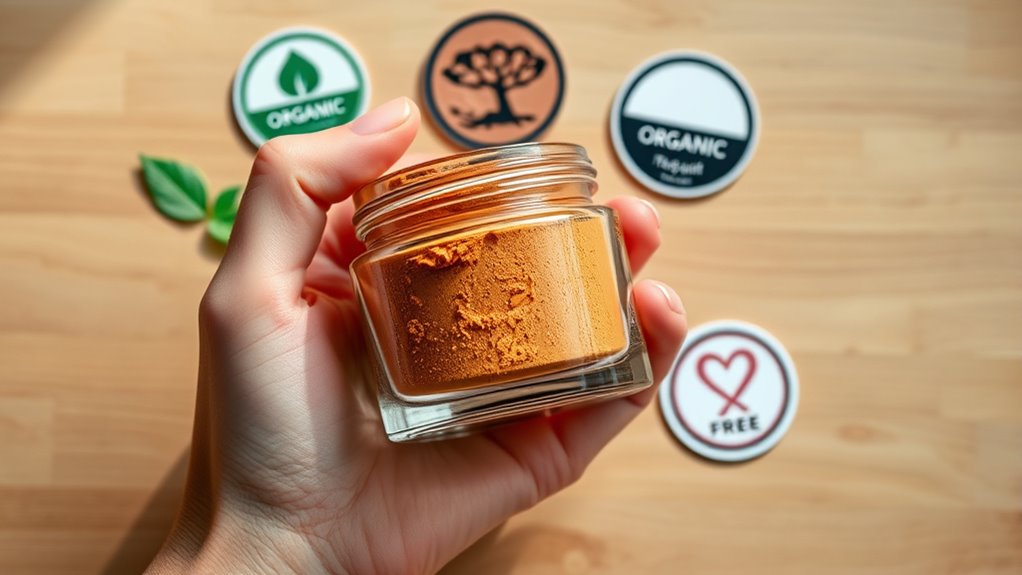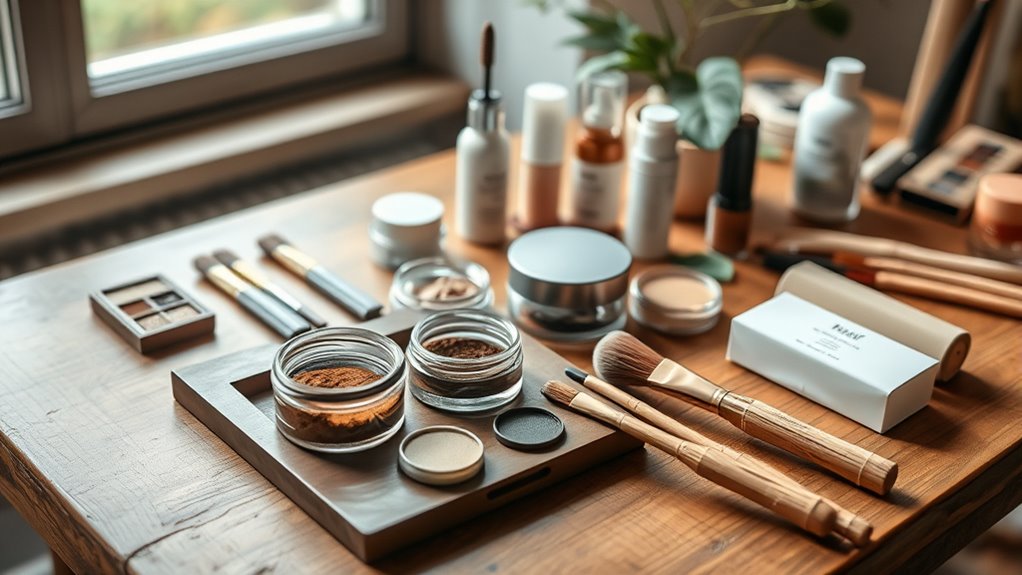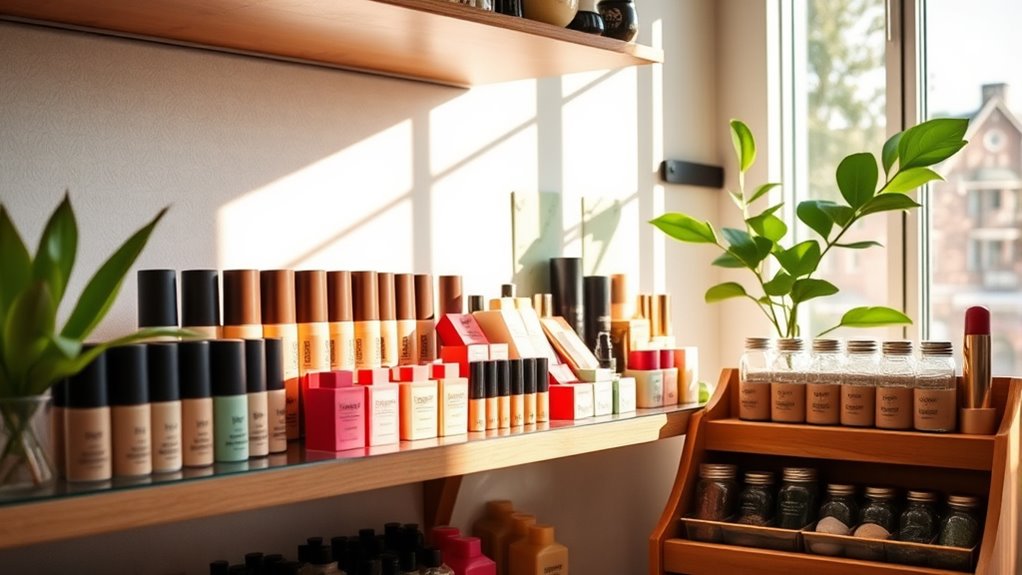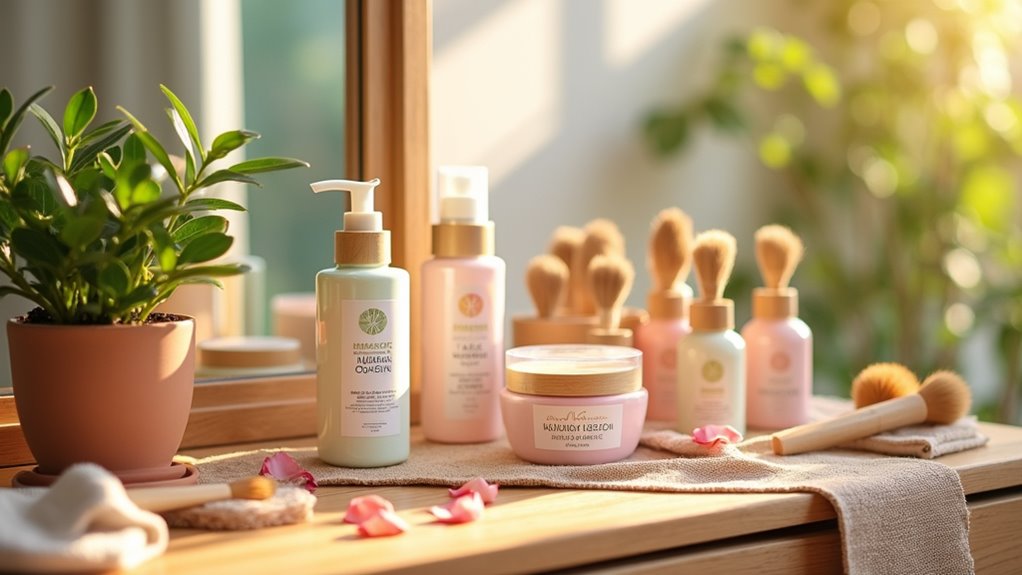A guide to natural and organic makeup helps you understand the difference between these products, what ingredients to look for or avoid, and how to identify trustworthy labels and certifications. You’ll learn about benefits like fewer chemicals and eco-friendly sourcing, plus practical tips for choosing safe products and incorporating them into your routine. If you want to make informed choices that align with your values and skin health, exploring further will give you all the essentials.
Key Takeaways
- Understand the differences between natural and organic makeup, including ingredient sourcing and certification standards.
- Learn which ingredients to seek for skin nourishment and which harmful chemicals to avoid.
- Recognize trusted labels and certifications like USDA Organic and COSMOS for product authenticity.
- Discover benefits of switching to natural and organic makeup, such as reduced irritations and eco-friendly packaging.
- Incorporate natural makeup gradually with proper application techniques for a healthier, sustainable beauty routine.
Understanding the Difference Between Natural and Organic Makeup

Have you ever wondered what truly sets natural and organic makeup apart? It all comes down to ingredient sourcing and how products interact during use. Natural makeup uses ingredients derived from plants, minerals, or other natural sources, but they aren’t necessarily grown or processed without chemicals. Organic makeup, on the other hand, emphasizes ingredients sourced from organic farming, meaning they’re grown without synthetic pesticides or fertilizers. This difference impacts chemical reactions within the product and your skin. Organic products often undergo stricter standards, ensuring fewer synthetic additives and more ethically sourced ingredients. Additionally, sustainable sourcing practices are often associated with organic products, reflecting a commitment to environmental responsibility. This focus on eco-friendly practices aligns with the principles of water conservation and reduced chemical use in production. Understanding these distinctions helps you choose makeup that aligns with your values and skin needs. By paying attention to ingredient sourcing, you can better grasp what makes natural and organic makeup unique.
Key Ingredients to Look for and Avoid

Choosing the right makeup involves more than just color and coverage; it also depends on the ingredients. You want products with ingredient safety and transparent ingredient sourcing. Look for key ingredients like plant-based oils, mineral pigments, and botanical extracts that nourish your skin. These ingredients are generally safer and sustainably sourced, reducing your exposure to harmful chemicals. Additionally, selecting products with certifications and endorsements from beauty experts can further ensure quality and authenticity. Avoid ingredients such as synthetic fragrances, parabens, phthalates, and talc, which can irritate your skin or disrupt hormones. Being vigilant about ingredient sourcing ensures you’re choosing products that prioritize safety and sustainability. By understanding these key ingredients, you can make informed choices that support your skin’s health and align with your values. Prioritize natural, organic ingredients for a safer, more effective makeup routine.
Certifications and Labels to Trust

Wondering how to guarantee your makeup products truly align with natural and organic standards? The key is to look for trusted certifications and labels. These symbols indicate that products meet specific certification standards, ensuring proper ingredient sourcing and transparency. For example, labels like USDA Organic or COSMOS certify that ingredients are responsibly sourced, non-toxic, and free from harmful chemicals. Always check the certification details on the packaging, not just the logo. Keep in mind that some labels might be confusing or misleading, so doing a quick online review of the certifying organization can help. Additionally, understanding how certification standards can influence your choices helps you stay informed and discerning. Recognizing reputable certification organizations ensures you’re selecting truly natural options. By choosing products with reputable certifications, you can confidently select makeup that aligns with your commitment to natural, clean beauty.
Benefits of Switching to Natural and Organic Products

Switching to natural and organic makeup products offers a range of tangible health and environmental benefits. You’ll reduce your exposure to harmful chemicals, which can cause skin irritation or long-term health issues. Plus, many brands prioritize eco friendly packaging, helping lessen plastic waste and pollution. Organic ingredients are often sustainably sourced, supporting healthier ecosystems. Additionally, choosing cruelty free testing guarantees no animal suffering. By making the switch, you contribute to a more ethical beauty industry. You also enjoy products crafted with fewer synthetic additives, resulting in gentler, more natural results for your skin. Moreover, natural and organic makeup frequently features innovative formulations that enhance skin health without compromising efficacy. Overall, embracing natural and organic makeup aligns your beauty routine with your values, promoting both personal wellness and a healthier planet.
Tips for Reading Product Labels Effectively

When reading product labels, start by spotting certification logos like USDA Organic or COSMOS to verify authenticity. Learn to recognize ingredient names so you can identify potential allergens or synthetic chemicals. Keep an eye out for harmful additives like parabens or phthalates to make safer choices.
Identify Certification Labels
Have you ever looked at a makeup product’s label and felt unsure about what the certifications really mean? Certification labels help verify claims about natural and organic ingredients, but they can also indicate quality control and ethical standards. Look for seals from trusted organizations, such as USDA Organic or COSMOS. These labels ensure proper ingredient sourcing and help you avoid cosmetic adulteration. Keep in mind that some labels may be misleading or incomplete. Additionally, understanding certification standards can help you better interpret the credibility of these labels. Learning about organic certification processes can further assist in making informed choices and ensuring the authenticity of your products. Familiarizing yourself with regulatory guidelines is also essential for recognizing genuine certifications and avoiding counterfeit claims. Recognizing labeling regulations can empower you to make healthier and more ethical beauty choices.
Recognize Ingredient Names
Understanding the ingredient list on your makeup product is key to making informed choices. When you read chemical labels, focus on the names of ingredients rather than marketing claims. Recognize ingredient names by familiarizing yourself with common botanical sources and synthetic components. Look for natural ingredient sources like plant extracts or oils, which indicate a more organic formulation. Be wary of unfamiliar chemical labels that may hide synthetic additives or preservatives. Knowing how to identify ingredient sources helps you determine if a product aligns with your natural and organic goals. Remember, ingredient lists are typically ordered by concentration, so ingredients at the top are present in larger amounts. Additionally, understanding the ingredient sourcing can help you choose products that truly meet your standards. By becoming comfortable with these names, you gain confidence in selecting products that truly meet your standards.
Spot Harmful Additives
To spot harmful additives on your product labels, you need to familiarize yourself with common chemical names that are often used as preservatives, stabilizers, or fillers. Watch out for ingredients like synthetic fragrances, which can cause skin irritation or allergic reactions, and artificial dyes such as FD&C or D&C dyes, linked to health issues. These additives are often hidden under complex names, so reading labels carefully is essential. Additionally, understanding Vetted – Halloween Product Reviews can help you recognize brands that prioritize safer, natural ingredients. Being aware of regulatory standards can also aid in identifying truly safe products, as some harmful additives may be permitted but still pose health risks. Look for terms like parabens, phthalates, or formaldehyde releasers, which are common preservatives in conventional makeup. Avoid products containing synthetic fragrances, as they often hide a cocktail of undisclosed chemicals. Check for artificial dyes like Red 40 or Yellow 5, which can cause sensitivities. Prioritize labels that list natural alternatives or are free from these harmful additives altogether. Additionally, paying attention to ingredient transparency ensures you are fully informed about what goes into your makeup products. Being aware of labeled certifications can also help you identify products that meet safety standards and are less likely to contain harmful substances.
Popular Natural and Organic Makeup Brands

Several brands stand out when it comes to natural and organic makeup that delivers quality without compromising your values. These brands prioritize sustainable packaging and are committed to cruelty-free testing, ensuring you feel good about what you use. Imagine makeup products in eco-friendly containers, free from harmful chemicals, tested ethically, and designed to minimize waste. Embracing minimalist principles in packaging can further enhance your eco-conscious beauty routine. Additionally, staying informed about AI Safety developments helps brands ensure their products meet high safety and ethical standards. Incorporating transparent ingredient lists can help consumers make more informed choices aligned with their values. Being aware of regulatory standards ensures that products adhere to safety guidelines and industry best practices.
How to Incorporate Natural Makeup Into Your Routine

Integrating natural makeup into your daily routine can be seamless when you start with small, intentional steps. Focus on proper application techniques to enhance your natural beauty and avoid heavy layers. Begin with a clean, moisturized face, and use gentle strokes to apply products evenly. When it’s time to remove makeup, opt for natural, gentle removers that preserve your skin’s health. To deepen your routine, consider these tips:
- Use a damp beauty sponge or soft brushes for flawless application
- Layer products lightly to build a natural look
- Choose multi-use products to simplify your routine
- Follow every makeup session with a thorough, natural makeup removal process
This approach helps you maintain a fresh, healthy complexion while embracing natural beauty.
Common Myths and Misconceptions

Many people believe that natural makeup is harsh or less effective, but that’s not true. Organic products aren’t automatically safer, and allergen-free doesn’t mean everyone won’t react. It’s important to understand these myths so you can make informed choices.
Natural Doesn’t Mean Harsh
Just because a makeup product is labeled as natural or organic doesn’t mean it has to be harsh on your skin. Many assume that natural ingredients automatically cause irritation, but that’s a misconception. Products free from harsh ingredients can still be effective and gentle, especially for sensitive skin. Always check labels for irritants like alcohol or synthetic fragrances, which can trigger reactions. Natural ingredients such as chamomile or aloe vera often soothe rather than harm. Remember, not all natural ingredients are suitable for everyone, so patch testing is key. Look for formulations that prioritize skin compatibility without compromising on performance. With mindful choices, you can enjoy the benefits of natural makeup without exposing your skin to unnecessary harsh ingredients.
Organic Equals Safer Products
While natural ingredients can be gentle on your skin, assuming that all organic products are inherently safer is a common misconception. Organic labels often lead people to believe the product is free from harmful chemicals, but that’s not always true. Some organic products still contain chemical preservatives necessary to extend shelf life, and these aren’t always safer than synthetic alternatives. Additionally, synthetic fragrances are frequently used to improve scent, yet they can cause irritation or allergic reactions, regardless of the product’s organic status. Just because a product is labeled organic doesn’t guarantee it’s completely free of potentially harmful ingredients. Always read the ingredient list carefully, and don’t assume that organic equals safer—education and awareness are key to making informed choices.
Allergen-Free Is Guaranteed
A common misconception is that products labeled allergen-free are completely safe for everyone. While hypoallergenic formulas and fragrance-free options reduce the risk of reactions, they don’t guarantee safety for all skin types or allergies. Allergens vary from person to person, and some ingredients may still cause irritation. It’s essential to read labels carefully and patch-test new products before regular use. Keep in mind that “allergen-free” isn’t regulated universally, so claims can be misleading. Even hypoallergenic formulas can contain rare irritants. Fragrance-free options are a good choice for sensitive skin but aren’t foolproof. Always consult with a dermatologist if you have specific allergies or sensitivities to verify that the product truly fits your needs.
Where to Shop for Authentic Natural and Organic Makeup

Finding authentic natural and organic makeup can be straightforward if you know where to look. Start by exploring trusted online retailers specializing in clean beauty, as they often curate brands committed to transparency and quality. Visit local health food stores or eco-friendly boutiques, where staff can guide your makeup application choices aligned with your skincare routines. Look for certifications like USDA Organic or Leaping Bunny, which verify product authenticity. Reading reviews and ingredient lists helps ensure you’re purchasing genuine products. Avoid mass-market brands that claim natural but lack transparency. By shopping at reputable sources, you ensure your makeup supports healthy skin and aligns with your values, making your makeup application routine both effective and eco-conscious.
Frequently Asked Questions
How Long Does Natural Makeup Typically Last on the Skin?
Natural makeup usually lasts around 4 to 8 hours on your skin, but product longevity depends on ingredient stability and your skin type. If you have oily skin, it might wear off quicker, while dry skin can help it stay longer. To boost longevity, use a primer and setting spray. Keep in mind that natural ingredients can be more delicate, so proper application and touch-ups are key for lasting beauty.
Are Natural and Organic Makeup Products Suitable for Sensitive Skin?
Did you know that about 60% of people with sensitive skin find natural and organic products more tolerable? If you’re concerned, look for products with hypoallergenic formulas and ingredient transparency, which reduce irritation risks. Natural and organic makeup often contains fewer synthetic chemicals, making them suitable for sensitive skin. However, always patch-test new products to verify they don’t cause reactions and choose brands that prioritize ingredient clarity.
Can Natural Makeup Provide the Same Coverage as Conventional Products?
You might wonder if natural makeup provides the same coverage as conventional products. Coverage comparison shows that natural options often offer a lighter, more breathable finish, but formulation differences can impact how well they conceal imperfections. While they might not be as full-coverage, many natural makeup brands are improving, allowing you to achieve a look that’s both effective and gentle on your skin.
How Often Should I Replace Natural Makeup Products?
You should replace natural makeup products every 6 to 12 months, depending on their shelf life. Always check expiration dates on packaging, and pay attention to changes in smell, texture, or color. Proper storage tips include keeping products in a cool, dry place away from sunlight, which helps extend their shelf life. Regular replacement prevents bacteria buildup, ensuring your makeup remains safe and effective for your skin.
Are There Affordable Options for High-Quality Natural Makeup Brands?
You can find affordable, high-quality natural makeup brands through drugstore finds and budget-friendly brands. Many stores now carry natural options that don’t break the bank, so you don’t have to compromise quality for price. Look for brands that focus on clean ingredients but offer competitive prices. With a little research, you’ll discover great options that fit your budget while keeping your beauty routine natural and effective.
Conclusion
Switching to natural and organic makeup isn’t just about avoiding chemicals—it’s about embracing a healthier, more radiant you. While traditional products might promise glamour, they often hide hidden ingredients. By choosing authenticity over allure, you empower your skin and the environment. So, don’t settle for superficial beauty—prioritize products that nourish and protect. Because true beauty shines brightest when it’s natural, honest, and consciously chosen.









